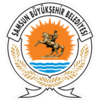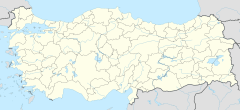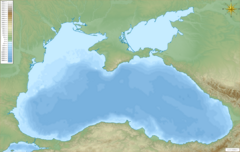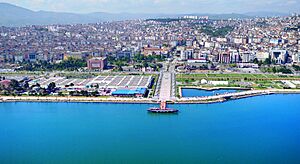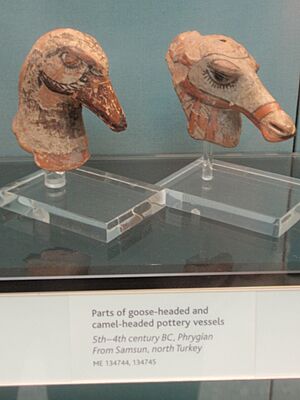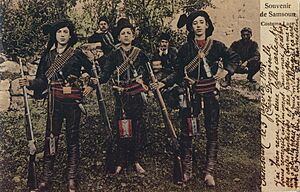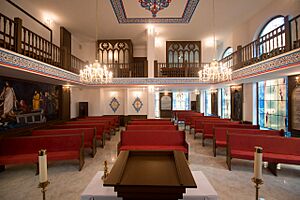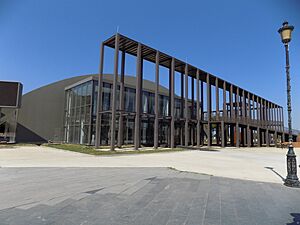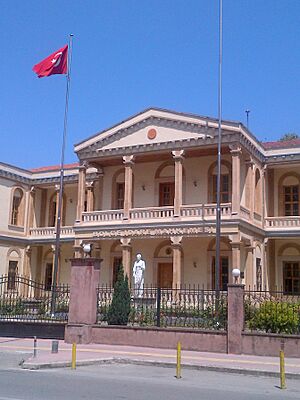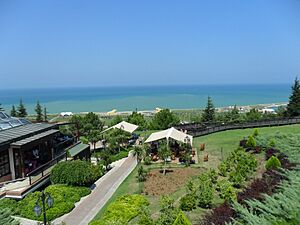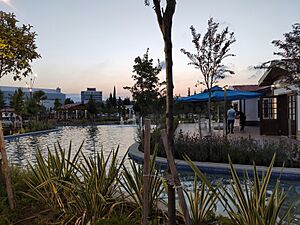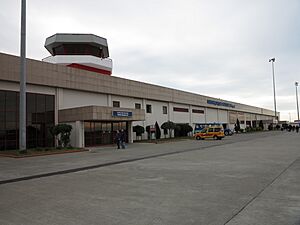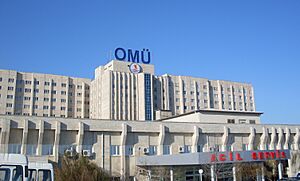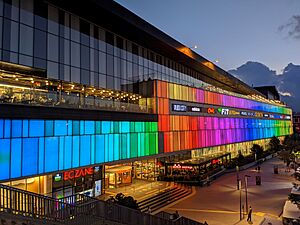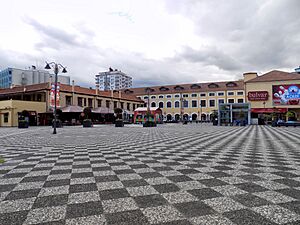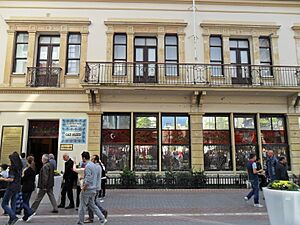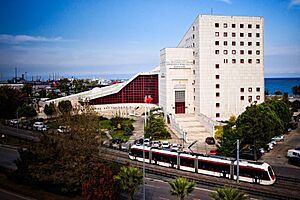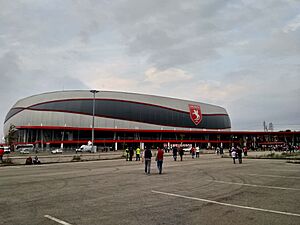Samsun facts for kids
Quick facts for kids
Samsun
|
||
|---|---|---|
|
Metropolitan municipality
|
||
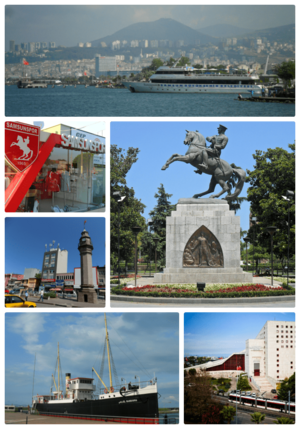
Clockwise from top right: Samsunum-1 ship and coast, Statue of Honor, Atatürk Culture Centre, Bandırma Ferry and National Struggle Park Open Air Museum, Saathane Square, Store 55
|
||
|
||
| Country | Turkey | |
| Region | Black Sea | |
| Province | Samsun | |
| Boroughs |
List
Atakum
Canik İlkadım Tekkeköy |
|
| Area | ||
| • Metropolitan municipality | 1,055 km2 (407 sq mi) | |
| Elevation | 4 m (13 ft) | |
| Population
(2021)
|
||
| • Metropolitan municipality | 1,356,079 | |
| • Density | 573/km2 (1,480/sq mi) | |
| • Urban | 710,000 | |
| GDP | ||
| • Metropolitan municipality | TRY 74.830 billion US$ 8.332 billion (2021) |
|
| • Per capita | TRY 54,873 US$ 6,110 (2021) |
|
| Time zone | UTC+03:00 (TRT) | |
| Postal code |
55
|
|
| Area code(s) | (+90) 362 | |
| Licence plate | 55 | |
| Climate | Cfa | |
| Website | www.samsun.bel.tr www.samsun.gov.tr | |
Samsun is a large city on the northern coast of Turkey. It is an important Black Sea port. More than 700,000 people live in the city. Samsun is the capital of Samsun Province, which has over 1.3 million people.
The city is home to Ondokuz Mayıs University, several hospitals, and large shopping malls. It also has the Samsunspor football club and an opera house. Samsun is known as the place where Mustafa Kemal Atatürk started the Turkish War of Independence in 1919.
Contents
- Understanding the Name of Samsun
- Exploring Samsun's History
- Samsun's Geography
- Samsun's Population
- Samsun's Buildings and Architecture
- Getting Around Samsun (Transport)
- Samsun's Economy
- Tourism and Fun in Samsun
- Samsun's Culture
- Learning in Samsun (Education)
- Parks and Green Spaces
- Sports in Samsun
- Samsun's Sister Cities
- Famous People from Samsun
- See also
Understanding the Name of Samsun
The name Samsun likely comes from its old Greek name, Amisós. People used to say "eís Amisón," meaning "to Amisós." This phrase, combined with a Greek ending for place names, changed over time to Samsun.
Long ago, a Greek historian named Hecataeus said Amisos was once called Enete. This place is mentioned in Homer's Iliad, a very old story. It talks about people called Enetoi living in Paphlagonia, near the Black Sea, around 1200 BC.
Samsun was also known by other names, like Peiraieos by settlers from Athens. For a short time, it was even called Pompeiopolis after a Roman leader, Pompey. During the Ottoman Empire, the city's name was written as Ṣāmsūn. It has been called Samsun since Turkey became a republic in 1923.
Exploring Samsun's History
Ancient Times in Samsun
You can see very old tools from the Stone Age at the Samsun Archaeology Museum. These were found in the Tekkeköy Caves.
Scientists have also found signs of early settlements from the Copper Age and Bronze Age at places like Dündartepe and Tekkeköy.
Samsun was first settled around 760–750 BC by people from Miletus, a Greek city. They called it Amisos. The city was great for trade because it had fertile land and shallow waters for ships.
Persian and Roman Rule
The Persians took over Amisos in 550 BC. Later, in the 5th century BC, Amisos became a free state and joined a group of Greek cities led by Athens. It was renamed Peiraeus.
Around 300 BC, the city came under the control of Mithridates I, who founded the Kingdom of Pontus. Treasure found in Amisos might have belonged to one of these kings. You can see old tombs from this period at Amisos Hill.
The Romans conquered Amisos in 71 BC. It became part of the Roman province of Bithynia et Pontus. Around 46 BC, Amisos became the capital of Roman Pontus.
By 150 AD, about 20,000 to 25,000 people lived in Amisos. It was an important trading city, even more so than nearby Sinope, because it was at the start of a major road across Anatolia.
Early Christianity in Samsun
Samsun was one of the first places where Christians gathered. As a big port city, it was easy for people to travel to and from places like Jerusalem. Many Jewish people lived in Asia Minor, and early Christians often shared their message with Jewish communities.
In the 1st century, a Roman governor named Pliny the Younger wrote about Christians in Pontus. He described early Christian groups and his interactions with them. Many important early Christian leaders had ties to Amisus.
Medieval History of Samsun
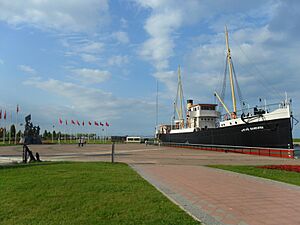
Samsun was part of different empires and kingdoms over time, including the Seljuk Empire and the Empire of Trebizond. It was also a trading post for the Genoese, who were Italian merchants.
In the late 13th century, the city was ruled by a small Turkish principality called the Isfendiyarids. The Ottoman Empire, which later became very powerful, captured Samsun in the late 14th century, but lost it again. The Ottomans finally took permanent control of Samsun in 1420.
During the Ottoman period, Samsun was known for growing tobacco. The local tobacco was very special and expensive. The city became connected to the railway in the late 1800s, which helped the tobacco trade grow a lot.
Modern Samsun
Mustafa Kemal Atatürk arrived in Samsun on May 19, 1919. This date is seen as the start of the Turkish War of Independence. Atatürk, who was an Ottoman officer, decided to start a national movement against the Allied powers who had occupied parts of Turkey.
During this time, there were some difficult events, including the movement of local Greek people to other parts of Anatolia. By 1920, Samsun's population was about 36,000, but it decreased due to the war. In June 1922, the city was attacked by Allied ships.
After Turkey won its independence and became a republic, Samsun quickly began to rebuild. In 1929, the first electric power plant in the region started working. Railways connected Samsun to cities like Sivas and Ankara in the 1950s. Roads were also greatly improved in the 1960s.
In 1975, Ondokuz Mayıs University was built nearby. This brought a major educational and medical center to Samsun. In 1998, the Samsun-Çarşamba Airport opened, connecting the city by air. The Samsun Tram network started in 2008, making travel easier within the city.
In 1993, Samsun became a "metropolitan municipality," which means it's a very important city in Turkey. It has continued to grow and develop. Large shopping malls and tall buildings have been built, changing the city's skyline.
Samsun's Geography
Samsun is a long city that stretches along the coast. It is located between two river deltas that reach into the Black Sea. The old city of Amisos was on a headland northwest of today's city center.
The city is growing quickly. New land has been created from the sea, and many new apartment buildings and shopping centers are being built. Industries are moving to the east, further away from the city center and closer to the airport.
Rivers of Samsun
To the west of Samsun is the Kızılırmak ("Red River"). It is one of the longest rivers in Anatolia and has a very fertile delta. To the east is the Yeşilırmak ("Green River") and its delta. The River Mert also flows into the sea at Samsun.
Samsun's Climate
Samsun has a humid subtropical climate. This means it has warm summers and cool, wet winters.
Summers are warm, with average high temperatures around 27°C in August. Winters are cool to mild and wet, with average low temperatures around 4°C in January.
It rains most in late autumn and early winter. Snow can fall between December and March, but temperatures rarely stay below freezing for long. The sea water is usually mild, ranging from 8°C to 20°C throughout the year.
| Climate data for Samsun (1991–2020, extremes 1929–2023) | |||||||||||||
|---|---|---|---|---|---|---|---|---|---|---|---|---|---|
| Month | Jan | Feb | Mar | Apr | May | Jun | Jul | Aug | Sep | Oct | Nov | Dec | Year |
| Record high °C (°F) | 24.2 (75.6) |
26.5 (79.7) |
33.6 (92.5) |
37.0 (98.6) |
37.4 (99.3) |
37.4 (99.3) |
37.5 (99.5) |
39.0 (102.2) |
38.7 (101.7) |
38.4 (101.1) |
32.4 (90.3) |
28.9 (84.0) |
39.0 (102.2) |
| Mean daily maximum °C (°F) | 11.1 (52.0) |
11.3 (52.3) |
12.8 (55.0) |
15.3 (59.5) |
19.4 (66.9) |
24.4 (75.9) |
27.4 (81.3) |
28.2 (82.8) |
24.8 (76.6) |
20.8 (69.4) |
16.7 (62.1) |
13.1 (55.6) |
18.8 (65.8) |
| Daily mean °C (°F) | 7.5 (45.5) |
7.3 (45.1) |
8.7 (47.7) |
11.3 (52.3) |
15.9 (60.6) |
20.8 (69.4) |
23.9 (75.0) |
24.5 (76.1) |
20.9 (69.6) |
17.0 (62.6) |
12.6 (54.7) |
9.4 (48.9) |
15.0 (59.0) |
| Mean daily minimum °C (°F) | 4.4 (39.9) |
4.1 (39.4) |
5.2 (41.4) |
7.9 (46.2) |
12.4 (54.3) |
17.0 (62.6) |
20.0 (68.0) |
20.7 (69.3) |
17.3 (63.1) |
13.6 (56.5) |
9.1 (48.4) |
6.5 (43.7) |
11.5 (52.7) |
| Record low °C (°F) | −8.1 (17.4) |
−9.8 (14.4) |
−7.0 (19.4) |
−2.4 (27.7) |
2.7 (36.9) |
7.8 (46.0) |
13.4 (56.1) |
12.4 (54.3) |
6.8 (44.2) |
1.5 (34.7) |
−2.8 (27.0) |
−5.0 (23.0) |
−9.8 (14.4) |
| Average precipitation mm (inches) | 72.5 (2.85) |
53.5 (2.11) |
68.5 (2.70) |
54.0 (2.13) |
54.1 (2.13) |
51.6 (2.03) |
38.9 (1.53) |
47.2 (1.86) |
51.8 (2.04) |
79.0 (3.11) |
76.1 (3.00) |
82.5 (3.25) |
729.7 (28.73) |
| Average precipitation days | 14.7 | 13.9 | 15.97 | 14.13 | 12.63 | 10.43 | 6.03 | 6.53 | 10.43 | 13.07 | 11.73 | 13.87 | 143.4 |
| Average relative humidity (%) | 65.9 | 67.8 | 72.5 | 76.8 | 78.0 | 74.0 | 71.2 | 70.9 | 72.2 | 73.6 | 67.8 | 64.4 | 71.2 |
| Mean monthly sunshine hours | 86.8 | 96.1 | 120.9 | 162.0 | 201.5 | 249.0 | 279.0 | 263.5 | 201.0 | 148.8 | 120.0 | 89.9 | 2,018.5 |
| Mean daily sunshine hours | 2.8 | 3.4 | 3.9 | 5.4 | 6.5 | 8.3 | 9.0 | 8.5 | 6.7 | 4.8 | 4.0 | 2.9 | 5.5 |
| Source 1: Turkish State Meteorological Service (extremes) | |||||||||||||
| Source 2: NOAA (humidity, 1991–2020) | |||||||||||||
Samsun's Population
Many people living in Samsun today have ancestors who moved there from other parts of the Black Sea coast. Most people in Samsun are Muslim.
Samsun's population grew slowly until 1990. After that, the city's population started to increase quickly. In 1990, about 323,000 people lived there. By 2020, the estimated population was 710,000.
Samsun's Buildings and Architecture
Like many old Ottoman cities, Samsun used to have buildings made of stone, like mosques and markets. But most homes were made of wood. Wealthy families had large wooden houses called konaks or yalis.
Starting in the 1950s, as the city grew, many old wooden buildings were replaced with concrete apartment blocks. These are now the most common type of building in the city center. The government has been working to replace older, unplanned housing with modern, planned homes.
Important Mosques
- Pazar Mosque: This is Samsun's oldest building, built by the Ilkhanate Mongols in the 13th century.
- Central Great Mosque: Built in 1884.
- Hacı Hatun Mosque: Dates back to 1694.
Churches in Samsun
- Samsun Protestant Church - located in Atakum
- Mater Dolorasa Church - located in Ilkadim
Samsun used to have several Greek Orthodox churches. However, most were destroyed or changed into mosques after the Turkish War of Independence.
Tallest Buildings
The tallest building in Samsun is Gökdelen Towers Tower 1, which is 115 meters tall. The Sheraton Hotel Samsun is also 115 meters tall. In recent years, many mid-rise buildings have been built, changing the city's skyline.
Getting Around Samsun (Transport)
You can travel to Samsun by long-distance buses. The main bus station is outside the city center, but most bus companies offer free rides to it if you have a ticket. Passenger and freight trains connect Samsun to Sivas and Ankara. The train station is in the city center.
The Samsun Tram runs between the eastern district of Tekkeköy and Ondokuz Mayıs University. There are also city buses, some of which are electric. Dolmuş are shared minibuses that follow specific routes.
The Samsun Amisos Hill Gondola is a 320-meter-long cable car that takes you to the Amisos Hill. Here, you can see ancient tombs.
Samsun-Çarşamba Airport is 23 km east of the city. You can get there by Havas service buses. Horse-drawn carriages, called fayton, are available along the seafront.
Samsun's Economy
Samsun has a diverse economy. It has many businesses related to medical industries.
Ports and Shipbuilding
Samsun is an important port city. In the early 1900s, a harbor was built to make it easier for ships to deliver goods. Before that, ships had to anchor far from shore.
The port in the city center handles cargo and ferries that travel to Russia. Fishing boats use a separate harbor. A new shipbuilding yard is being built on the eastern edge of the city. Samsun's port connects central Anatolia to the sea, allowing goods to be shipped in and out.
Manufacturing and Food Processing
There is an industrial area between the city and the airport. Samsun makes medical devices, furniture (using imported wood), tobacco products, chemicals, and car parts. Flour mills in Samsun import wheat and export some of the flour.
Shopping in Samsun
Samsun has many new shopping malls. Some were built specifically for shopping, while an old tobacco factory in the city center was turned into a mall. The largest mall in Samsun is Piazza Samsun.
Tourism and Fun in Samsun
Nature and Outdoor Activities
Samsun has one of the longest coastlines in the Black Sea Region, stretching for 35 km. Most of this coastline has sandy beaches perfect for swimming. You can also try sports like surfing, jet skiing, and sailing. Samsun has 39 beaches in total, with 19 of them in Atakum. Many beaches have been awarded the Blue Flag, meaning they are very clean.
For winter fun, the Akdağ Winter Sports and Ski Center in Ladik is a great place. It has a long ski track and a chair lift. Akdağ is also popular for paragliding, mountaineering, and exploring highlands. Nebiyan Mountain is visited by mountaineers, and Kunduz Mountains are known for summer pastures.
You can also visit natural spots like Asarağaç Hill, Gölalan Waterfalls, and Kabaceviz Waterfall. Nature parks like Çamgölü, Sarıgazel, and Vezirköprü are also popular. The Kızılırmak Delta is a special place for bird watching.
Samsun also has thermal springs, which are hot springs with mineral-rich water. These springs, like the May 25 Thermal Tourism Center in Havza, are used for health tourism. People visit them to help with conditions like rheumatic diseases.
Samsun's Culture
The Atatürk Culture Center
The Atatürk Culture Center (AKM) is a place where concerts and other performances are held. The "Samsun State Opera and Ballet" performs here. It was started in 2009 and is one of six state opera houses in Turkey. They have performed famous operas like Madama Butterfly.
Museums to Visit
- Archaeological and Atatürk Museum: This museum shows old items found in the Samsun area, including the Amisos treasure. The Atatürk section has photos and personal items of Mustafa Kemal Atatürk.
- Atatürk (Gazi) Museum: This museum houses Atatürk's bedroom, study, and meeting room, along with some of his personal belongings.
- Samsun City Museum: A newer museum about the city's history.
- Surgical Instruments and Health Museum: Opened in 2021, this museum focuses on medical tools and health.
Folk Dancing
Samsun hosts an international folk dancing festival every year.
Learning in Samsun (Education)
Samsun has two universities: the public Ondokuz Mayıs University and the private Samsun University. There are also other colleges and training centers.
Parks and Green Spaces
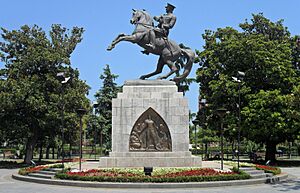
- Parks
- Batı Park (West Park): A large park built on land reclaimed from the sea.
- Doğu Park (East Park): Another large park.
- Atatürk Park: This park has a famous statue of Mustafa Kemal Atatürk by Austrian sculptor Heinrich Krippel. The statue was completed in 1931.
- Nature Reserves
- Çakırlar Korusu
Sports in Samsun
In ancient Roman times, gladiator fights might have happened in Amisos. This is shown on an old tombstone from the 2nd or 3rd century CE.
The Tekkeköy Yaşar Doğu Arena opened in 2013.
Football is the most popular sport in Samsun. The city's main team is Samsunspor, which plays its games at the Samsun 19 Mayıs Stadium.
Other popular sports include basketball, volleyball, tennis, swimming, cable skiing (in summer), horse riding, go-karting, paintballing, and martial arts. Cycling and jogging are common along the seafront, where people also enjoy fishing.
Samsun's Sister Cities
Samsun has "sister city" relationships with many cities around the world. These partnerships help promote cultural exchange and friendship.
 North Little Rock, Arkansas, United States (2006)
North Little Rock, Arkansas, United States (2006) Gorgan, Iran (2006)
Gorgan, Iran (2006) İskele, Northern Cyprus (2006)
İskele, Northern Cyprus (2006) Novorossiysk, Russia (2007)
Novorossiysk, Russia (2007) Dar es Salaam, Tanzania (2007)
Dar es Salaam, Tanzania (2007) Kalmar, Sweden (2008)
Kalmar, Sweden (2008) Bordeaux, France (2010)
Bordeaux, France (2010) Kiel, Germany (2010)
Kiel, Germany (2010) Brčko, Bosnia and Herzegovina (2012)
Brčko, Bosnia and Herzegovina (2012) Bizerte, Tunisia
Bizerte, Tunisia Donetsk, Ukraine
Donetsk, Ukraine Accra, Ghana
Accra, Ghana Bishkek, Kyrgyzstan
Bishkek, Kyrgyzstan
Famous People from Samsun
Footballers
- Mete Adanır (1961–1989), Turkish Cypriot football player
- Nuri Asan (1940–1989), football player and manager
- Serkan Aykut (born 1975), former football player
- Tanju Çolak (born 1963), former football player, born in Samsun
Other Notable People
- Orhan Gencebay (born 1944), a famous Turkish music artist
- Levent Kırca (1950–2015), comedian, actor, and politician
See also
 In Spanish: Samsun para niños
In Spanish: Samsun para niños


